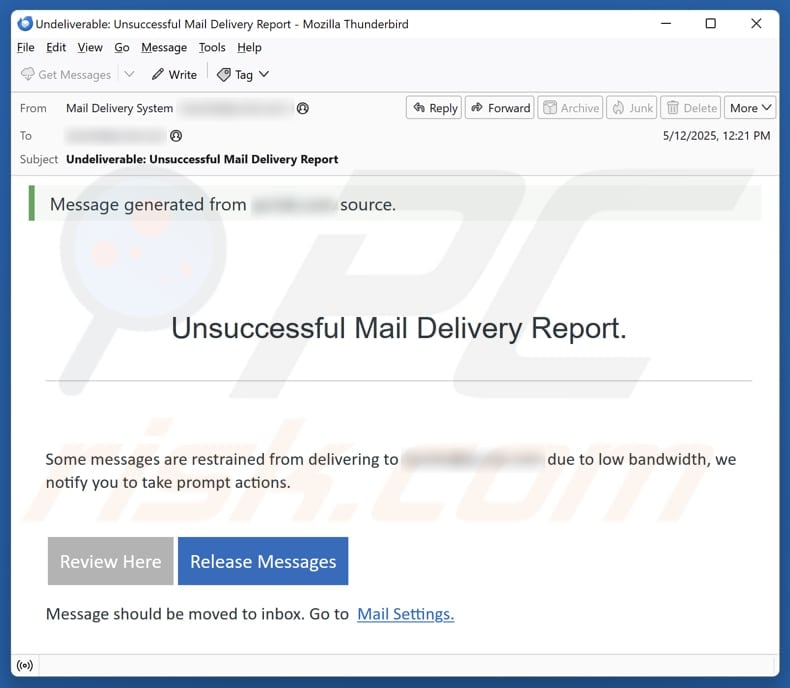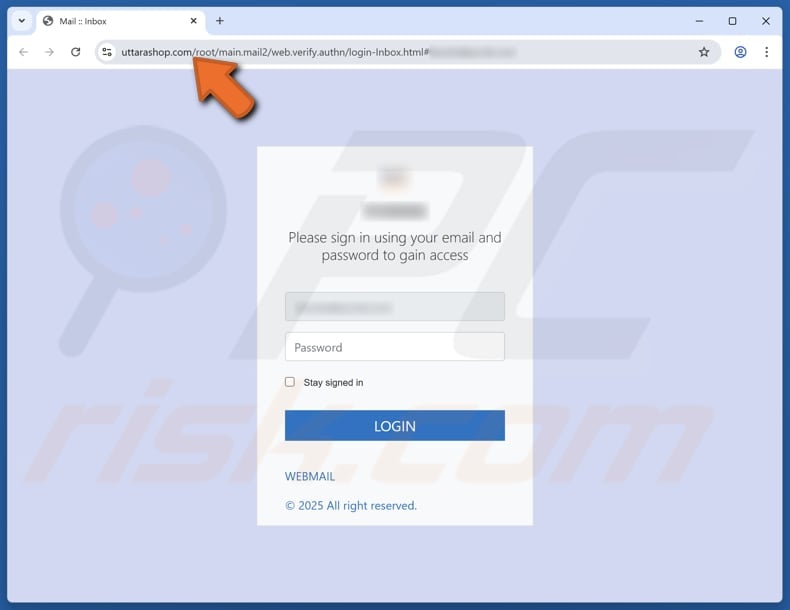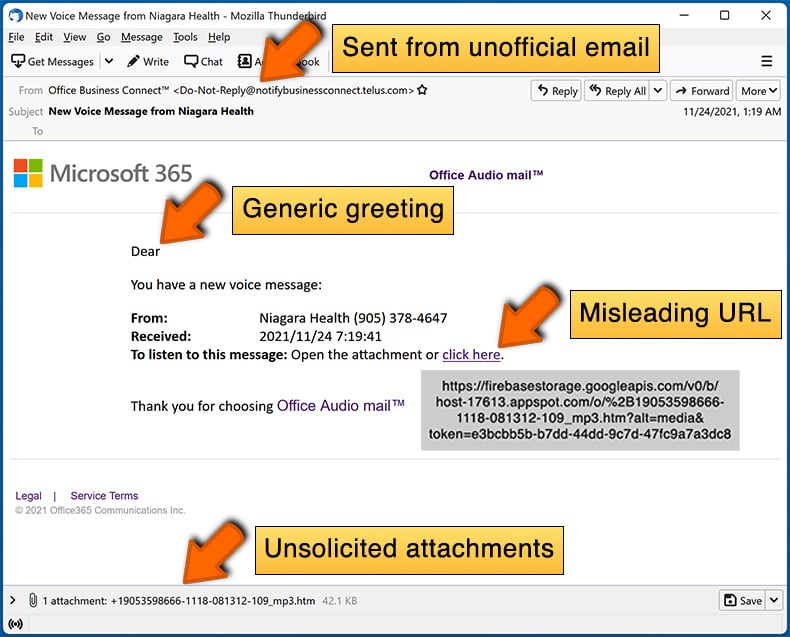How to identify phishing emails like "Unsuccessful Mail Delivery Report"
Phishing/ScamAlso Known As: Unsuccessful Mail Delivery Report deceptive email notification
Get free scan and check if your device is infected.
Remove it nowTo use full-featured product, you have to purchase a license for Combo Cleaner. Seven days free trial available. Combo Cleaner is owned and operated by RCS LT, the parent company of PCRisk.com.
What kind of scam is "Unsuccessful Mail Delivery Report"?
Our review of the email has revealed that it is a fraudulent message posing as a notification from an email service regarding unsuccessful mail delivery. It is created to deceive recipients into entering personal information on a fake web page. Such schemes are known as phishing emails. Recipients should avoid interacting with them.

More about the "Unsuccessful Mail Delivery Report" scam email
The email claims that some messages could not be delivered due to "low bandwidth". It urges the recipient to take immediate action by clicking on deceptive links labeled "Review Here" and "Release Messages". The email also suggests that the blocked messages should be moved to the inbox and instructs the recipient to access their mail settings.
However, these links lead to a fraudulent website designed to steal login credentials. On the page, users are requested to sign in using their email address and password to gain access. If provided, this information is sent to scammers, who can exploit it for malicious purposes.
With access to email accounts, scammers can harvest personal information from emails and send scam emails (or deliver malware) to contacts (or email addresses of their choice). Also, fraudsters can try to access other accounts (e.g., social media or banking) using the stolen login credentials.
If they succeed, they may be able to steal more personal information (e.g., credit card details or ID card information), make fraudulent purchases or transactions, or take other malicious actions. Thus, it is important to recognize scam emails and never respond to them (or open links or files) to avoid negative outcomes.
| Name | Unsuccessful Mail Delivery Report Email Scam |
| Threat Type | Phishing, Scam, Social Engineering, Fraud |
| Fake Claim | Emails cannot be delivered due to low bandwidth |
| Disguise | Notification from an email service provider |
| Related Domain | uttarashop[.]com |
| Detection Names (uttarashop[.]com) | Abusix (Spam), CRDF (Malicious), Fortinet (Phishing), Sophos (Spam), URLQuery (Suspicious), Full List Of Detections (VirusTotal) |
| Symptoms | Unauthorized online purchases, changed online account passwords, identity theft, illegal access of the computer. |
| Distribution methods | Deceptive emails, rogue online pop-up ads, search engine poisoning techniques, misspelled domains. |
| Damage | Loss of sensitive private information, monetary loss, identity theft. |
| Malware Removal (Windows) |
To eliminate possible malware infections, scan your computer with legitimate antivirus software. Our security researchers recommend using Combo Cleaner. Download Combo CleanerTo use full-featured product, you have to purchase a license for Combo Cleaner. 7 days free trial available. Combo Cleaner is owned and operated by RCS LT, the parent company of PCRisk.com. |
Conlusion
In conclusion, this email is a classic example of a phishing attempt designed to mislead recipients into taking harmful actions (such as disclosing personal details). Users should always be cautious with unexpected emails that urge immediate action, especially those containing suspicious links.
Examples of similar scam emails are "Mailbox Storage Notification", "Capital One - Unlock Your Account Access", and "PayPal - Money Received". Another reason to avoid interacting with such emails is that they can be used to trick users into infecting their computers.
How do spam campaigns infect computers?
Cybercriminals use email to spread malware by attaching harmful files or embedding malicious links. Typical malicious attachments include executable files, Office documents, PDFs, compressed archives (e.g., ZIP or RAR), script files, and ISO images. The malware is activated only when the recipient opens the file or performs certain actions, such as enabling macros in an infected document.
Alternatively, such emails may contain links that direct users to malicious websites. These sites may initiate automatic downloads or use deceptive tactics to persuade users to download the malware manually.
How to avoid installation of malware?
Exercise caution with unexpected and suspicious emails or other messages, especially from unfamiliar senders. Do not open attachments or click on links within these messages. Avoid allowing notification permissions from questionable pages. When downloading apps or files, use trusted platforms like official websites or verified app stores.
Do not trust (click on) pop-ups, ads, or suspicious links on shady sites. Regularly update your operating system and applications, and use trusted antivirus tools to safeguard your device from potential threats. If you have already opened malicious attachments, we recommend running a scan with Combo Cleaner Antivirus for Windows to automatically eliminate infiltrated malware.
Text presented in the "Unsuccessful Mail Delivery Report" email letter:
Subject: Undeliverable: Unsuccessful Mail Delivery Report
Unsuccessful Mail Delivery Report.
Some messages are restrained from delivering to - due to low bandwidth, we notify you to take prompt actions.
Review Here
Release MessagesMessage should be moved to inbox. Go to Mail Settings.
Phishing website used in this scam:

Instant automatic malware removal:
Manual threat removal might be a lengthy and complicated process that requires advanced IT skills. Combo Cleaner is a professional automatic malware removal tool that is recommended to get rid of malware. Download it by clicking the button below:
DOWNLOAD Combo CleanerBy downloading any software listed on this website you agree to our Privacy Policy and Terms of Use. To use full-featured product, you have to purchase a license for Combo Cleaner. 7 days free trial available. Combo Cleaner is owned and operated by RCS LT, the parent company of PCRisk.com.
Quick menu:
- What is Unsuccessful Mail Delivery Report deceptive email notification?
- Types of malicious emails.
- How to spot a malicious email?
- What to do if you fell for an email scam?
Types of malicious emails:
![]() Phishing Emails
Phishing Emails
Most commonly, cybercriminals use deceptive emails to trick Internet users into giving away their sensitive private information, for example, login information for various online services, email accounts, or online banking information.
Such attacks are called phishing. In a phishing attack, cybercriminals usually send an email message with some popular service logo (for example, Microsoft, DHL, Amazon, Netflix), create urgency (wrong shipping address, expired password, etc.), and place a link which they hope their potential victims will click on.
After clicking the link presented in such email message, victims are redirected to a fake website that looks identical or extremely similar to the original one. Victims are then asked to enter their password, credit card details, or some other information that gets stolen by cybercriminals.
![]() Emails with Malicious Attachments
Emails with Malicious Attachments
Another popular attack vector is email spam with malicious attachments that infect users' computers with malware. Malicious attachments usually carry trojans that are capable of stealing passwords, banking information, and other sensitive information.
In such attacks, cybercriminals' main goal is to trick their potential victims into opening an infected email attachment. To achieve this goal, email messages usually talk about recently received invoices, faxes, or voice messages.
If a potential victim falls for the lure and opens the attachment, their computers get infected, and cybercriminals can collect a lot of sensitive information.
While it's a more complicated method to steal personal information (spam filters and antivirus programs usually detect such attempts), if successful, cybercriminals can get a much wider array of data and can collect information for a long period of time.
![]() Sextortion Emails
Sextortion Emails
This is a type of phishing. In this case, users receive an email claiming that a cybercriminal could access the webcam of the potential victim and has a video recording of one's masturbation.
To get rid of the video, victims are asked to pay a ransom (usually using Bitcoin or another cryptocurrency). Nevertheless, all of these claims are false - users who receive such emails should ignore and delete them.
How to spot a malicious email?
While cyber criminals try to make their lure emails look trustworthy, here are some things that you should look for when trying to spot a phishing email:
- Check the sender's ("from") email address: Hover your mouse over the "from" address and check if it's legitimate. For example, if you received an email from Microsoft, be sure to check if the email address is @microsoft.com and not something suspicious like @m1crosoft.com, @microsfot.com, @account-security-noreply.com, etc.
- Check for generic greetings: If the greeting in the email is "Dear user", "Dear @youremail.com", "Dear valued customer", this should raise suspiciousness. Most commonly, companies call you by your name. Lack of this information could signal a phishing attempt.
- Check the links in the email: Hover your mouse over the link presented in the email, if the link that appears seems suspicious, don't click it. For example, if you received an email from Microsoft and the link in the email shows that it will go to firebasestorage.googleapis.com/v0... you shouldn't trust it. It's best not to click any links in the emails but to visit the company website that sent you the email in the first place.
- Don't blindly trust email attachments: Most commonly, legitimate companies will ask you to log in to their website and to view any documents there; if you received an email with an attachment, it's a good idea to scan it with an antivirus application. Infected email attachments are a common attack vector used by cybercriminals.
To minimise the risk of opening phishing and malicious emails we recommend using Combo Cleaner Antivirus for Windows.
Example of a spam email:

What to do if you fell for an email scam?
- If you clicked on a link in a phishing email and entered your password - be sure to change your password as soon as possible. Usually, cybercriminals collect stolen credentials and then sell them to other groups that use them for malicious purposes. If you change your password in a timely manner, there's a chance that criminals won't have enough time to do any damage.
- If you entered your credit card information - contact your bank as soon as possible and explain the situation. There's a good chance that you will need to cancel your compromised credit card and get a new one.
- If you see any signs of identity theft - you should immediately contact the Federal Trade Commission. This institution will collect information about your situation and create a personal recovery plan.
- If you opened a malicious attachment - your computer is probably infected, you should scan it with a reputable antivirus application. For this purpose, we recommend using Combo Cleaner Antivirus for Windows.
- Help other Internet users - report phishing emails to Anti-Phishing Working Group, FBI’s Internet Crime Complaint Center, National Fraud Information Center and U.S. Department of Justice.
Frequently Asked Questions (FAQ)
Why did I receive this email?
Scam emails are typically part of large-scale campaigns sent to numerous recipients. Your address may have been collected from a previous data breach, a hacked website, or other sources. These messages are usually generic and not personally targeted.
I have provided my personal information when tricked by this email, what should I do?
If there is a chance that any of your accounts were exposed, it is important to change their passwords immediately. If they cannot be accessed, contact their support team.
I have downloaded and opened a file attached to an email, is my computer infected?
Malicious attachments pose a threat only when users engage with them. For instance, malware hidden in Microsoft Office documents often relies on users enabling macros to initiate the infection, whereas executable files can trigger harmful activity as soon as they are opened.
I have read the email but did not open the attachment, is my computer infected?
Simply viewing an email is usually harmless. However, clicking on suspicious links or opening infected attachments within the message can result in malware being planted on your device.
Will Combo Cleaner remove malware infections that were present in email attachment?
Combo Cleaner can identify and eliminate most known malware threats. However, certain advanced infections may hide deep within the system, so performing a full system scan is necessary to ensure thorough detection and removal.
Share:

Tomas Meskauskas
Expert security researcher, professional malware analyst
I am passionate about computer security and technology. I have an experience of over 10 years working in various companies related to computer technical issue solving and Internet security. I have been working as an author and editor for pcrisk.com since 2010. Follow me on Twitter and LinkedIn to stay informed about the latest online security threats.
PCrisk security portal is brought by a company RCS LT.
Joined forces of security researchers help educate computer users about the latest online security threats. More information about the company RCS LT.
Our malware removal guides are free. However, if you want to support us you can send us a donation.
DonatePCrisk security portal is brought by a company RCS LT.
Joined forces of security researchers help educate computer users about the latest online security threats. More information about the company RCS LT.
Our malware removal guides are free. However, if you want to support us you can send us a donation.
Donate
▼ Show Discussion